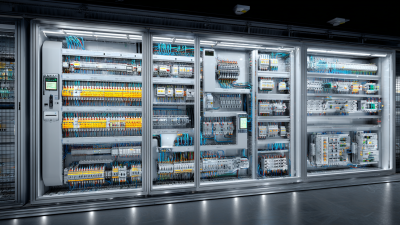As we navigate through the 21st century, the integration of Automation Systems has emerged as a transformative force across various industries, redefining operational landscapes and enhancing productivity. According to a report by McKinsey, it is estimated that automation could increase global productivity by up to 1.4% annually, with sectors like manufacturing and logistics witnessing unprecedented efficiency gains. The International Federation of Robotics highlighted that shipments of industrial robots reached a record of over 420,000 units in 2020, reflecting a growing trend towards automated solutions in production processes. Furthermore, businesses adopting automation have reported a reduction in operational costs by as much as 30%, as noted in Deloitte’s Global Human Capital Trends report. This convergence of technology and industry is poised to reshape the future, paving the way for innovative processes and sustainable growth driven by Automation Systems.

Automation systems are transforming industries by integrating advanced technologies that enhance efficiency and productivity. Key components of these systems include sensors, controllers, and actuators, which work together to facilitate real-time data collection and process automation. For instance, according to a report by McKinsey, automation could raise global productivity growth by 0.8 to 1.4 percent annually. This potential is evident in sectors such as manufacturing, where the adoption of automation technologies can lower operational costs by up to 20% while increasing production rates significantly.
Moreover, the advancements in artificial intelligence and machine learning are pivotal in the evolution of automation systems. A study from PwC indicates that AI alone could contribute over $15.7 trillion to the global economy by 2030, reflecting its profound impact on various industries. In logistics, companies implementing autonomous vehicles and robotic systems are streamlining supply chains, achieving improvements in accuracy and speed. As industries increasingly rely on these automation technologies, understanding their components will be essential for businesses aiming to leverage these innovations to maintain a competitive edge.
As automation technology advances, a growing number of industries are reaping substantial benefits from these innovations. The financial services sector is a prime example, where generative AI is reshaping operations by fostering innovation and streamlining processes. According to industry reports, organizations embracing AI tools have seen significant reductions in operational costs, while enhancing customer service and risk management capabilities.
The energy sector, particularly photovoltaic power generation, is also experiencing a transformation due to automation. As global energy demands escalate, automation systems play a critical role in optimizing production efficiency and integrating renewable energy sources. Data shows that automated photovoltaic systems can increase energy output by up to 20%, significantly contributing to sustainability goals and addressing the global energy conundrum.
Tip: To maximize the benefits of automation in your industry, assess current processes for automation possibilities and focus on training your workforce to leverage new technologies effectively. This approach will not only improve operational efficiency but also foster a culture of innovation within your organization.
As industries worldwide embrace automation, implementing these systems successfully requires a strategic approach. According to a report by McKinsey Global Institute, up to 60% of all occupations could see 30% or more of their tasks automated by the early 2030s. This presents a significant opportunity for businesses to enhance productivity and efficiency, but transitioning to automation also poses challenges that must be navigated carefully.

To facilitate a smooth transition, companies should begin by assessing their specific automation needs. The World Economic Forum emphasizes the importance of aligning automation goals with overall business strategy. This involves identifying repetitive tasks that can be automated to free up human resources for more complex responsibilities. Next, investing in employee training is crucial; research by PwC indicates that companies that prioritize reskilling their workforce can unlock up to $1.3 trillion in economic value by 2030. By taking a measured and inclusive approach to automation, organizations can ensure they not only integrate new technology effectively but also foster a culture of innovation and adaptability among their teams.
Automation systems are increasingly at the forefront of industrial innovation, leading to significant efficiency and productivity gains across various sectors. By integrating advanced technologies like Artificial Intelligence and machine learning into operational processes, companies can streamline workflows, reduce human error, and optimize resource management. This transition not only enhances output but also allows businesses to allocate their human resources to more strategic tasks, ultimately fostering a culture of innovation.
Tips to maximize the impact of automation systems include thorough training for employees on new technologies, as well as a phased implementation strategy. This gradual adoption helps teams adjust to the changes while minimizing disruptions to existing operations. Additionally, regular analysis and feedback loops can identify bottlenecks and opportunities for further optimization, ensuring that organizations remain agile and responsive to shifting market demands.
Emphasizing data-driven decision-making is crucial in measuring the true impact of automation. By utilizing metrics and KPIs, businesses can monitor productivity levels in real-time and make informed adjustments where necessary. Continuous evaluation not only solidifies the gains achieved through automation but also helps in crafting a roadmap for future improvements and innovations.

As we look towards the future, the landscape of automation is undergoing a remarkable transformation fueled by pioneering innovations. One of the most significant trends reshaping industries is the integration of artificial intelligence (AI) and machine learning into automation systems. These technologies allow for more complex decision-making processes, enabling machines to adapt and learn from their environments. This not only enhances efficiency but also reduces human intervention, paving the way for smarter manufacturing and service operations.
Another notable trend is the rise of collaborative robots, or cobots, which are designed to work alongside human workers rather than replace them. These systems are equipped with advanced sensors and AI capabilities, allowing them to safely operate in shared workspaces. This shift is particularly relevant in sectors such as healthcare and agriculture, where the synergy between human expertise and robotic efficiency can yield impressive results. As these innovations continue to evolve, they signal a future where automation not only optimizes operations but also enhances the human experience in the workplace.






